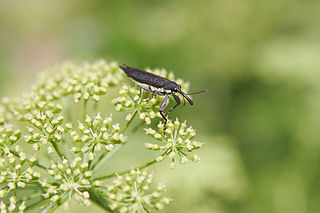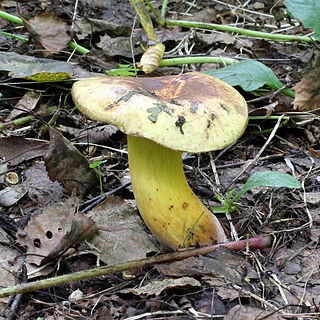
The Curculionidae are the family of the "true" weevils. They are one of the largest animal families, with 6,800 genera and 83,000 species described worldwide. They are the sister group to the subfamily Brentidae

Weevils are beetles belonging to the superfamily Curculionoidea, known for their elongated snouts. They are usually small, less than 6 mm in length, and herbivorous. About 97,000 species of weevils are known. They belong to several families, with most of them in the family Curculionidae. Some other beetles, although not closely related, bear the name "weevil", such as the biscuit weevil, which belongs to the family Ptinidae.

Psammodynastes pulverulentus, the common mock viper, is a species of snake native to Asia.

The Cape grey mongoose, also called the small grey mongoose, is a small mammal native to South Africa, Lesotho and southern Namibia.

Cryptorhynchinae is a large subfamily of weevils (Curculionidae), with some 6000 species. They are found in most zoogeographic regions although they are most diverse in the Neotropics, Australia and Oceania.

The smoky flying squirrel, or "Smokies," is a species of rodents in the family Sciuridae. It is monotypic within the genus Pteromyscus. It is found in parts of Brunei, Indonesia, Peninsular Malaysia, and southern Thailand, but its range may be more extensive than currently mapped. Their natural habitat is subtropical or tropical dry forests. It is listed as an endangered species because of estimated population loss of 50% in past and future, judging from extensive and rapid habitat loss.

Otiorhynchus is a large genus of weevils in the family Curculionidae. Many species of the genus, particularly the black vine weevil and the strawberry root weevil, are important pests, both as larvae and as adults. Larvae feed on plant roots. Adults are flightless with fused elytra and feed at night on plant foliage. In many species of the genus at least some races are polyploid and parthenogenetic, while the rest of the races and species are diploid and bisexual. Otiorhynchus weevils, particularly O. scaber, have been a popular subject for studies of the evolution of parthenogenesis. The genus is native to the Palearctic region. However, sixteen species were inadvertently introduced to North America and have become widespread there.

Sitona is a large genus of weevils in the family Curculionidae native to the Nearctic and Palaearctic regions. Over 100 species have been described. Sitona is easily distinguished from related genera by flat, recumbent scales on the mandibles, by the absence of an oval scar on the mandibles, by short and broad rostrum with a deep, longitudinal, median groove, and by dense scales on the body.

Cyanoboletus pulverulentus, commonly known as the ink stain bolete, is an edible bolete mushroom. It is found in deciduous and mixed forests, particularly on moist soil on slopes and under beech and oak trees. A common species, it is found in northern Asia, Europe, North Africa, Central and northern South America, and eastern North America. All parts of the mushroom will stain dark bluish-black after handling. The mushrooms used to be considered edible, but a recent study has revealed this mushroom hyperaccumulates arsenic and therefore its consumption should be restricted.

Gonipterus is a genus of weevils in the family Curculionidae. There are approximately 20 described species in the genus, most of which are native to Australia. They are all plant feeders and many are specific to a single host species. Gonipterus gibberus and Gonipterus scutellatus infest a number of species of Eucalyptus and have spread to other parts of the world where these trees have been planted.

Odontocorynus umbellae is a species in the weevil family.

Odontocorynus salebrosus is a species of weevils in the family Curculionidae. It occurs in Canada and U.S.A.

Rhynchophorus, or common name palm weevil, is a genus of beetles in the weevil family, Curculionidae. Palm weevils are major pests of various trees in the family Arecaceae throughout the tropics including: coconut, Areca catechu, species of the genus Phoenix, and Metroxylon sagu.

Ceutorhynchini is a true weevil tribe in the subfamily Baridinae.
The purple swamphen has been split into the following species:

Odontocorynus is a genus of flower weevils in the family of beetles known as Curculionidae. There are 16 described species in Odontocorynus.
Agnocoris pulverulentus is a species of plant bug in the family Miridae. It is found in North America.
Hypocryphalus is a genus of typical bark beetles in the family Curculionidae. There are more than 70 described species in Hypocryphalus.
Odontocorynus falsus is a species of flower weevil in the beetle family Curculionidae. It is found in North America.
Odontocorynus larvatus is a species of flower weevil in the beetle family Curculionidae. It is found in North America.














